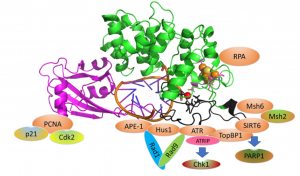New Article Published: When you’re strange: Unusual features of the MUTYH glycosylase and implications in cancer.
Think MUTYH is a simple adenine glycosylase? Think again. Explore the dizzying diversity of MUTYH interactions to DNA damage response proteins and their implications in cancer in our lab’s newest review by Alan Raetz and Sheila David.
Click here or on the image to link to the article!

Raetz, A.G.; David, S.S. When you’re strange: Unusual features of the MUTYH glycosylase and implications in cancer. DNA Repair. 2019, 80, 16-25.
#DavidLab #MUTYH #Muty #DNArepair #glycosylase #DDR #cancer #ucdavis #chemistry #chemicalbiology #AlanRaetz #SheilaDavid
